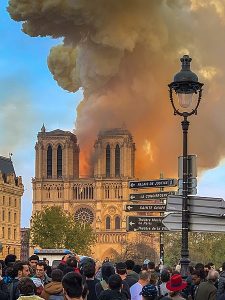
In the aftermath of Notre Dame’s catastrophic fire, several social issues have similarly seemed to ‘catch fire’. Some speak about the hypocrisy of the situation, seeing the generous donations of the rich in France as a way of buying the ‘indulgences’ for wealth inequalities. Others question why such donations are raised to restore a building, although a very important one, yet many environmental and social issues continue to lack resources… Finally, the Notre Dame fire has ignited controversies around the questions of religion and national identity in France. Notre Dame is the emblem of France, part of the French identity… and it is also a Catholic cathedral… Is Catholicism then part of the French identity? And are you less French if you didn’t mourn the burning church? Such claims might be seen as religiously discriminating, although discrimination may exist apart from such claims. For example, as estimated by The French Interior Ministry, in France there is one church for every 275 Catholic worshippers, while there is one mosque for every 1,300 Muslims. One billion dollars have been raised for the reconstruction of the Catholic Notre Dame, while building a new Mosque is restricted by a foreign funding ban, for example.
In the light of this social dialogue, it was especially interesting to listen to a recent HBR podcast on the topic of managing religion in the workplace, where similar claims of religious discrimination seem to be on the rise.
Podcast guest and Harvard Business School professor, Derek van Bever, argues that managers appear unprepared to manage issues of religious diversity and possible discrimination at work. As an example, van Bever discusses two relevant court cases. The 2008 Abercrombie & Fitch case was about a young Muslim woman named Samantha Elauf. The protagonist of the case was denied a salesperson job because of wearing a hijab that was considered a violation of the company’s dress code by the employer. The case was brought to the court, which ruled 8 to 1 against the employer.
The second case discussed by van Bever was the infamous Masterpiece Cake incident, where a cake baker denied a gay couple the service due to his religious beliefs. Specifically, baking a wedding cake for a same-sex marriage ceremony was perceived by the cakeshop owner as a violation of his Christian faith. As such, the court case initiated by the gay couple represented a complex standoff between discriminations based on sexual orientation (from their side) and religious discrimination (from the standpoint of the baker). In the end, the case was ruled in favor of the baker, and the decision was framed in terms of free exercise of religion.
Referring to such kind of examples, van Bever argues that the religious landscape is getting more complex and companies need to be prepared. Are there accommodating rules and regulations for people adhering to different religious practices in the organization? What if someone’s religion prohibits them from working on Sundays, or makes praying several times a day a necessity? Does the cafeteria in your organization provide choice that accommodates everyone? Are there dress code expectations that might go against one’s religious practice? All these questions indicate that similar to having policies with regard to gender diversity, racial diversity, LGBT rights, crisis situations and more, managers also need to think about written policies on handling issues of religion.


This is very inspiring. I hope i can emulate this oneday